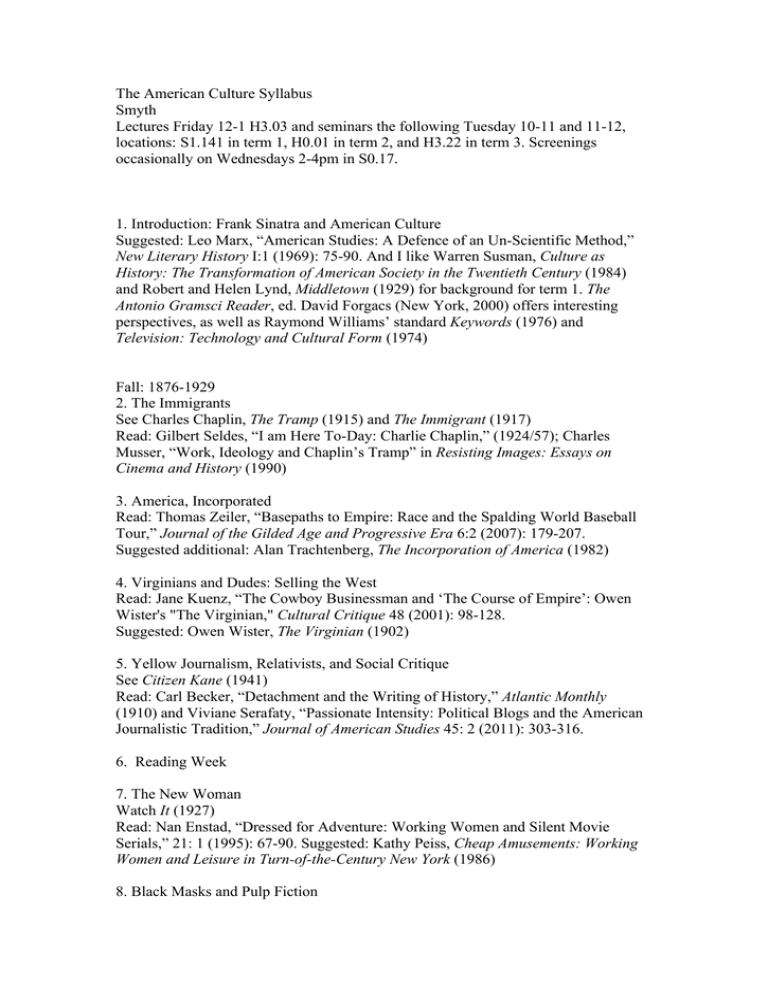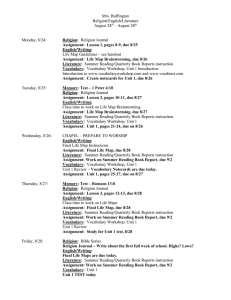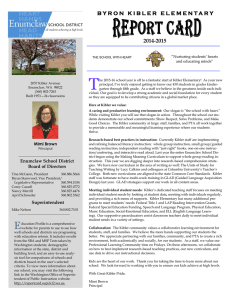The American Culture Syllabus Smyth
advertisement

The American Culture Syllabus Smyth Lectures Friday 12-1 H3.03 and seminars the following Tuesday 10-11 and 11-12, locations: S1.141 in term 1, H0.01 in term 2, and H3.22 in term 3. Screenings occasionally on Wednesdays 2-4pm in S0.17. 1. Introduction: Frank Sinatra and American Culture Suggested: Leo Marx, “American Studies: A Defence of an Un-Scientific Method,” New Literary History I:1 (1969): 75-90. And I like Warren Susman, Culture as History: The Transformation of American Society in the Twentieth Century (1984) and Robert and Helen Lynd, Middletown (1929) for background for term 1. The Antonio Gramsci Reader, ed. David Forgacs (New York, 2000) offers interesting perspectives, as well as Raymond Williams’ standard Keywords (1976) and Television: Technology and Cultural Form (1974) Fall: 1876-1929 2. The Immigrants See Charles Chaplin, The Tramp (1915) and The Immigrant (1917) Read: Gilbert Seldes, “I am Here To-Day: Charlie Chaplin,” (1924/57); Charles Musser, “Work, Ideology and Chaplin’s Tramp” in Resisting Images: Essays on Cinema and History (1990) 3. America, Incorporated Read: Thomas Zeiler, “Basepaths to Empire: Race and the Spalding World Baseball Tour,” Journal of the Gilded Age and Progressive Era 6:2 (2007): 179-207. Suggested additional: Alan Trachtenberg, The Incorporation of America (1982) 4. Virginians and Dudes: Selling the West Read: Jane Kuenz, “The Cowboy Businessman and ‘The Course of Empire’: Owen Wister's "The Virginian," Cultural Critique 48 (2001): 98-128. Suggested: Owen Wister, The Virginian (1902) 5. Yellow Journalism, Relativists, and Social Critique See Citizen Kane (1941) Read: Carl Becker, “Detachment and the Writing of History,” Atlantic Monthly (1910) and Viviane Serafaty, “Passionate Intensity: Political Blogs and the American Journalistic Tradition,” Journal of American Studies 45: 2 (2011): 303-316. 6. Reading Week 7. The New Woman Watch It (1927) Read: Nan Enstad, “Dressed for Adventure: Working Women and Silent Movie Serials,” 21: 1 (1995): 67-90. Suggested: Kathy Peiss, Cheap Amusements: Working Women and Leisure in Turn-of-the-Century New York (1986) 8. Black Masks and Pulp Fiction Sean McCann, “Constructing Race Williams: The Klan and the Making of HardBoiled Crime Fiction,” American Quarterly 49: 4 (1997): 677-716. Suggested: Dashiell Hammett, Red Harvest (1929) 9. Vaudeville and Theatrical Cultures M. Alison Kibler, “Rank Ladies, Ladies of Rank,” American Studies, vol. 38, no. 1 (spring, 1997): 97-115. Suggested: M. Alison Kibler, Rank Ladies: Gender and Cultural Hierarchy in American Vaudeville (2009); Eric Lott, Love and Theft, Blackface Milstrelsy and the American Working Class (rev. 2013) 10. Tramps, Vamps, and Gangsters Read: J. E. Smyth, Revisioning Modern History in the Age of Scarface,” Historical Journal of Film, Radio, and Television 24:4 (2004): 535-63; Marybeth Hamilton, “Mae West Live: Sex, The Drag, and 1920s Broadway,” TDR 36:4 (1992):82-100. Suggested: Gilbert Seldes, The Seven Lively Arts (1928); Fred Pasley, Al Capone: Biography of a Self-Made Man (1930) Winter: 1930-1985 11. Documenting the Depression Read: Chris Vials, “The Popular Front in the American Century: ‘Life’ Magazine, Margaret Bourke-White, and Consumer Realism, 1936-41,” American Periodicals 16: 1 (2006): 74-102. See also Michael Denning, The Cultural Front (1997); Studs Terkel, Hard Times (rev. 2005). 12. The Legend of Dorothy Thompson See Woman of the Year (1942) read: Lynn Gordon, “Why Dorothy Thompson Lost Her Job: Political Columnists and the Press Wars of the 1930s and 1940s,” History of Education Quarterly 34:3 (1994): 281-303. 13. Wartime Censorship and the Zoot Suit Jennifer Frost, “Dissent and Consent in the ‘Good War’: Hedda Hopper, Hollywood Gossip and World War II Isolationism,” Film History (2010): 170-181; Elizabeth Escobedo, “The Pachuca Panic: Sexual and Cultural Battlegrounds in World War II Los Angeles,” The Western Historical Quarterly 38:2 (2007): 133-56. See Clayton Koppes and Gregory Black, Hollywood Goes to War (1990); Catherine Ramirez, The Woman in the Zoot Suit (2009) if you want more. 14. The Organization Man read: Jesse Berrett, “Feeding the Organization Man: Diet and Masculinity in Postwar America,” Journal of Social History 30:4 (1997): 805-825; R.C. Lutz, “On the Road to Nowhere?: California’s Car Culture,” California History 79: 1 (2000): 50-55. Suggested: William Whyte, The Organization Man (1956). 15. The Second Wave and Intimate Revolts Read Shira Tarrant, “When Sex Became Gender: Mirra Komarovsky's Feminism of the 1950s,” Women Studies Quarterly 33:3/4 (2005): 334-55; Ann McGrath, “Being Annie Oakley,” Frontiers 28: 1/2 (2007): 203-31. Suggested: Susan Douglas, Where the Girls Are (1995) 16. Reading Week 17. Lenny Bruce: Underground Listen to all of Bruce on YouTube. Ioan Davies, “Lenny Bruce: Hyperrealism and the Death of Jewish Tragic Humor,” Social Text 22 (1989): 92-114. See David Kaufman, Jewhooing the Sixties (2012). 18. The Revolution Will Not Be Televized Watch Shaft (1971) Read: V.P. Franklin, “Jackanapes: Reflections on the Legacy of the Black Panther Party for the HipHop Generation,” Journal of African American History 92: 4 (2007): 553-60; Winston A Van Horne, “The Concept of Black Power: Its Continued Relevance,” Journal of Black Studies 37:3 (2007): 365-89. See also Bobby Seale, Seize the Time (1996) 19. States of Decay Watch Three Days of the Condor (1973) Gillian Frank, “Discophobia: Antigay Prejudice and the 1979 Backlash against Disco,” Journal of the History of Sexuality 16:2 (2007): 276-306; Mark Meister and Ann Burnett, “Rhetorical Exclusion in the Trial of Leonard Peltier,” American Indian Quarterly 28: 3/4 (2004): 719-42. 19. Star Wars Generation Read: Roddey Reid, “Foucault in America: Biography, Culture War, and the New Consensus,” Cultural Critique 35 (1996-1997): 179-211; Jennifer Holt, “In Deregulation We Trust: The Synergy of Politics and Industry in Reagan Era Hollywood,” Film Quarterly 55:2 (2001): 22-29. See: Michael Rogin, Ronald Reagan, The Movie, and Other Episodes in Political Demonology (1988) Spring: 1986-2000 1. Postmodern America from Jameson to Madonna Read: Darren Jorgensen, “Death Star, Or How I Learned to Stop Worrying and Love Globalization,” symploke 15: 1/2 (2007): 206-217; Stephen Brown et al., Teaching Old Brands New Tricks: Retro Branding and the Revival of Brand Meaning,” Journal of Marketing 67:3 (2003): 19-33. See Fredric Jameson, Postmodernism, or, The Cultural Logic of Late Capitalism (1990) 2. SoCal and the Erasure of History Watch Chinatown (1974) Dydia Delyser, “Ramona Memories: Fiction, Tourist Practices, and Placing the Past in Southern California,” Annals of the Association of American Geographers 93:4 (2003): 886-908; Madeline Y. Hsu, “ ‘Smoke and Mirrors’: Conditional Inclusion, model Minorities, and the Pre-1965 Dismantling of Asian Exclusion,” Journal of American Ethnic History 34: 4 (2015): 443-65. 3. Revision


